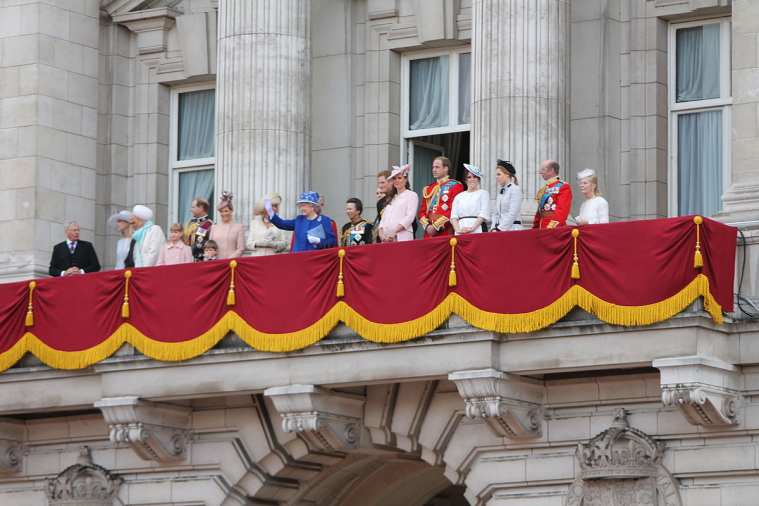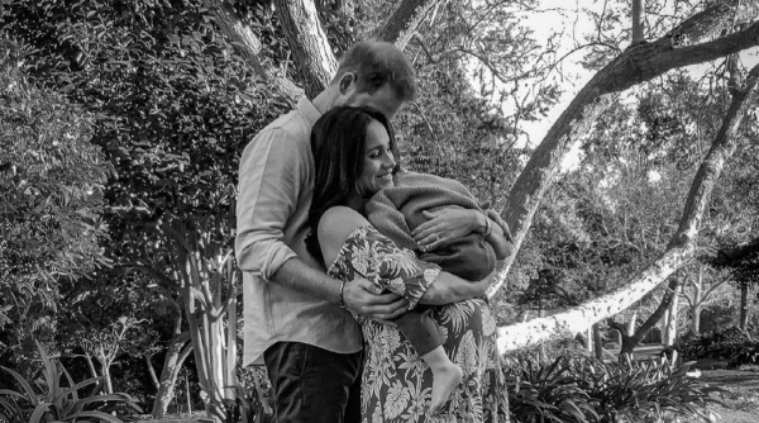What Is the Last Name of the British Royal Family
Lilibet Diana Mountbatten-Windsor, the newborn and second child of Prince Harry and Meghan Markle has made quite the news with her name. Her commencement proper noun, Lilibet, is a tribute to Queen Elizabeth as it was her nickname since she was a little daughter. Her 2d name, Diana was selected to honour her belatedly grandmother, the princess of Wales and female parent of Prince Harry. Her terminal name, Mountbatten-Windsor is interesting, since not all royals comport a surname. Lilibet's cousins, the children of Prince William and Catherine Middleton for instance, do not use a surname. At that place is a history to who among the British royals gets to employ a surname, and what that final proper name must exist.
The story behind Mountbatten-Windsor
Mountbatten and Windsor are the family names of Prince Philip and Queen Elizabeth respectively. The House of Windsor family proper noun was agreed upon past King George V in 1917. Earlier that, the royal family of the United Kingdom belonged to the German House of Saxe-Coburg and Gotha. The start sovereign of the firm was Ernest I who ruled over the dutchy by the same proper name from 1826 until his death in 1844. His eldest son, Prince Albert married Queen Victoria in 1840.
Since equally per tradition sovereigns took the name of their 'house' from their father, Queen Victoria'south eldest son, King Edward VII belonged to the Saxe-Coburg and Gotha. His son, George V, who succeeded to the throne in 1910 had dropped the family name. In 1917 the First World War was at its height and anti-German sentiment was running high among the people of Neat United kingdom of great britain and northern ireland. It was in these circumstances that the British royal family unit decided to change all High german titles and business firm names to anglicised forms. King George Five issued a royal proclamation in July 1917 declaring:
Now, therefore, We, out of Our Royal Will and Authorisation, do hereby declare and denote that as from the date of this Our Royal Annunciation Our House and Family shall exist styled and known equally the House and Family of Windsor, and that all the descendants in the male line of Our said Grandmother Queen Victoria who are subjects of these Realms, other than female person descendants who may marry or may have married, shall bear the said Name of Windsor
And do hereby further declare and announce that We for Ourselves and for and on behalf
of Our descendants and all other the descendants of Our said Grandmother Queen Victoria
who are subjects of these Realms, relinquish and enjoin the discontinuance of the use of the
Degrees, Styles, Dignities, Titles and Honours of Dukes and Duchesses of Saxony and Princes
and Princesses of Saxe-Coburg and Gotha, and all other High german Degrees, Styles, Dignities.
Titles, Honours and Appellations to U.s. or to them heretofore belonging or appertaining.
The King likewise decided to restrict the use of British princely titles to only those nearest to him. In 1919, for case, he stripped three of his German relations from British titles.
The Mountbatten family name of Prince Philip too has its origins in the flow of the Start World War. It is an anglicised version of 'Battenberg' which was the dynasty ruling over the K dutchy of Hesse in Germany. Two of the descendants of the Battenburg family unit got associated with the British royal family unit in the 19th century. Prince Henry of Battenberg married Princess Beatrice, the youngest kid of Queen Victoria, while his brother Prince Louis of Battenberg married the Queen'southward granddaughter Princess Victoria of Hesse and Rhine. Louis and Victoria's daughter, Princess Alice of Battenberg, was the mother of Prince Philip. Her brother, Louis Mountbatten was the last Viceroy of India.
 Members of the House of Windsor on the balcony of Buckingham Palace. (Wikimedia Commons)
Members of the House of Windsor on the balcony of Buckingham Palace. (Wikimedia Commons)
By 1939, when Prince Philip met and fell in dearest with Queen Elizabeth, he had taken on his mother'south surname, even though his father'southward side was Greek and Danish. Past and so, the Battenberg had also been given upward in preference to Mountbatten. On account of the anti-German language sentiment in Britain during the First World War, Prince Louise had dropped the Battenberg surname just three days before the British imperial family had their family name changed to Windsor. He along with his children and nephews also gave upwards on all German language titles. King George V compensated them with British titles.
Even though Queen Elizabeth II had confirmed House of Windsor to exist the family name when she succeeded to the throne in 1952 much to the disappointment of her husband, in 1960 she and Prince Philip decided that they would like their direct descendants to take both their family names as Mountbatten-Windsor. Other male person line descendants of King George V continue using the surname Windsor.
The selective employ of the surname
Interestingly, simply some among the straight descendants of Queen Elizabeth II and Prince Philip get to use the surname Mountbatten-Windsor. It also acts like a subconscious surname, used but when one is required. For example, when Princess Anne married Captain Marker Philips in 1973, the surname was used in the official wedlock register at Westminister Abbey. That was the first time the surname came to exist used officially. Information technology was used similarly when Prince Andrew got married in 1986.
Equally per tradition, royals with titles sign themselves with their start names merely. Simply not everyone in the regal family holds a princely title. King George V issued a Letters Patent in 1917 proclaiming that the great grandchildren of the monarch, apart from the eldest, would non automatically become prince or princesses.
 Prince Harry and Meghan Markle with son Archie (Misan Harriman/Instagram)
Prince Harry and Meghan Markle with son Archie (Misan Harriman/Instagram)
"The grandchildren of the sons of whatsoever such Sovereign in the direct male line (salve only the eldest living son of the eldest son of the Prince of Wales) shall have and enjoy in all occasions the manner and title enjoyed by the children of Dukes of these Our Realms," the patent stated.
As per this order, only Prince George, the eldest son of Prince William and third in line of succession was supposed to hold a championship. However, in 2013, the Queen issued a Letters Patent that bestowed the royal title upon all of William'due south children.
Since Prince Harry and Meghan Markle's children, Archie and Lilibet exercise not hold royal titles, they apply the surname Mountbatten-Windsor.
Source: https://indianexpress.com/article/research/mountbatten-windsor-the-story-behind-lilibets-last-name-7353734/
0 Response to "What Is the Last Name of the British Royal Family"
Post a Comment